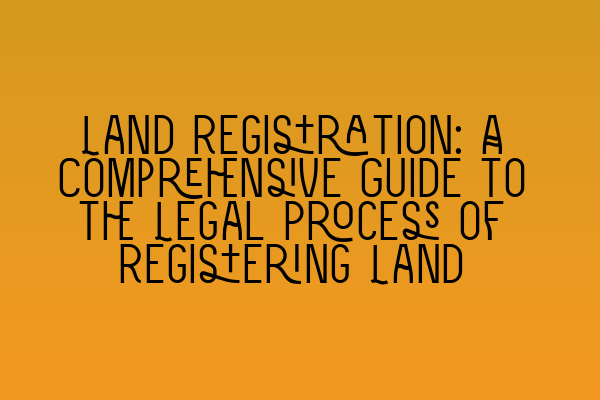Land Registration: A Comprehensive Guide to the Legal Process of Registering Land
Introduction:
Land registration is a crucial legal process that provides security and certainty in property ownership. Whether you are buying or selling land, registering your land with the appropriate authorities is essential to protect your rights and interests. In this comprehensive guide, we will explore the legal process of land registration, outlining the steps involved and the importance of each stage. So, let’s dive in!
1. Understanding Land Registration:
Land registration is the process of recording rights and interests in land within a centralized register. In the United Kingdom, land registration is handled by the Land Registry. Registering your land provides legal certainty and protection against fraudulent claims. It also establishes you as the legal owner of the land, allowing you to exercise your rights as a property owner.
2. Step 1: Preparation:
Before initiating the land registration process, it is crucial to gather all the necessary documents and information. This includes the title deeds, plans, and any relevant contracts or agreements. It is advisable to seek legal advice to ensure you have all the required documentation in order.
3. Step 2: Completing the Application Forms:
The next step is to complete the relevant application forms for land registration. These forms will vary depending on the type of registration being sought, such as first registration, transfer of ownership, or registration of leases. It is vital to accurately complete these forms to avoid any delays or complications in the registration process.
4. Step 3: Submitting the Application:
Once the application forms are completed, they must be submitted to the Land Registry along with the necessary supporting documents and fees. It is important to check the Land Registry’s website for the current fees and payment methods. Submitting the application online is usually more efficient and faster than submitting it by post.
5. Step 4: Examination and Processing:
Upon receiving the application, the Land Registry will examine the documents and verify the information provided. They will also conduct searches and investigate any potential issues, such as outstanding debts or disputes. This examination process ensures the accuracy of the register and prevents fraudulent registrations.
6. Step 5: Notice and Objections:
During the registration process, the Land Registry will publish a notice in the Local Land Charges Register, informing the public of the proposed registration. This allows interested parties to raise objections if they believe they have a legitimate claim or interest in the land. It is important to address any objections promptly to prevent delays in the registration process.
7. Step 6: Completion and Issue of Title:
Once all objections have been resolved, and the Land Registry is satisfied with the application, they will complete the registration process. A new title document will be issued, reflecting the registered owner and any registered interests or rights. This title document serves as proof of ownership and should be kept in a safe place.
Conclusion:
Land registration is a complex legal process that requires careful attention to detail and adherence to specific procedures. By following the steps outlined in this comprehensive guide, you can ensure a smooth and successful land registration process. Remember to seek professional legal advice to ensure you fully understand the implications and requirements of land registration.
For more related articles and resources on property law and land law, please check out the following links:
– SQE 1 Practice Exam Questions
– SQE 1 Practice Mocks FLK1 FLK2
– SQE 2 Preparation Courses
– SQE 1 Preparation Courses
– SRA SQE Exam Dates
Remember, professional legal advice is essential when dealing with land registration, and this guide serves as an informative resource to help you understand the process better.
